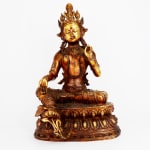Avalokiteśvara (Guanyin) Statue, Nineteenth to Twentieth Century AD
Gilt Bronze, Coloured Glass, Enamel
51.5 x 31.5 x 26 cm
20 1/4 x 12 3/8 x 10 1/4 in
20 1/4 x 12 3/8 x 10 1/4 in
CC.72
Further images
-
(View a larger image of thumbnail 1
)

-
(View a larger image of thumbnail 2
)

-
(View a larger image of thumbnail 3
)

-
(View a larger image of thumbnail 4
)

-
(View a larger image of thumbnail 5
)

-
(View a larger image of thumbnail 6
)

-
(View a larger image of thumbnail 7
)

-
(View a larger image of thumbnail 8
)

-
(View a larger image of thumbnail 9
)

-
(View a larger image of thumbnail 10
)

-
(View a larger image of thumbnail 11
)

Avalokiteśvara, known to the Chinese as Guanyin, is one of the most popular bodhisattvas in Tibetan Buddhism. S/he is the principal attendant of the Amitabha Buddha, and supposedly contains the...
Avalokiteśvara, known to the Chinese as Guanyin, is one of the most popular bodhisattvas in Tibetan Buddhism. S/he is the principal attendant of the Amitabha Buddha, and supposedly contains the compassion of all the Buddhas. Avalokiteśvara has 108 avatars, some female and some male, and so artistic representations can depict her/him as either gender. The origins of this figure are shrouded in mystery. Some Western scholars have suggested that Avalokiteśvara, like many other magical figures in Buddhism, originated in the Hindu tradition, in particular as Shiva or Vishnu. The cult of Avalokiteśvara was especially popular in Tibetan Buddhism, where the recitation of the bodhisattva’s six-syllable mantra, oṃ maṇi padme hūṃ (‘praise to the jewel lotus’), is closely associated with personal devotion to Buddhist teachings.
This gilt-bronze figure represents Avalokiteśvara at ease, with one foot on a rest, leg raised, and the other leg folded in front of her. She sits upright, her slender torso slightly twisted. Her eyes are downcast, in a guise of meditation; the corners of her mouth are turned up in a slight, benign smile. Her ears are weighed down by heavy diamond-shaped earrings, which stretch her lobes. She has the urna dot on her forehead, a sign of her wisdom. She wears an elaborate crown of floral motifs, which culminates in a seated Buddha in front of a leaf-shape. It is this seated Buddha in her headdress that allows us to identify her as Avalokiteśvara. She is naked from the waist up, though is richly adorned with jewellery: around her neck is a large pectoral with the face of a lion, the protector of the dharma; her arms bear armlets with foliate plaques, also bearing leonine faces; she wears two long bead necklaces which stretch down to her navel, one picked out in coloured glass. She wears pleated trousers, also decorated with beads of coloured glass and enamel, and a golden chain that wraps around her legs. Her hands are held in two mudras, one – with ring finger and thumb touching – represents good fortune, the other the open-palmed varada mudra of generosity. The message is clearly that by following Avalokiteśvara, she will generously bestow good fortune.
Buddhism in Tibet saw something of a revival in the Eighteenth and Nineteenth Centuries AD, as the Chinese Qing Dynasty sought to secure their stranglehold on Tibet. As a result, the Qing Emperors sponsored the Gelug school of Tibetan Buddhism, and exported it to other parts of their Empire. Sino-Tibetan artists latched on to this state sponsorship, producing a great many high-quality works both for the local Tibetan market, and for further afield. The popularity of Avalokiteśvara in Tibet ensured that s/he was a popular subject.
This gilt-bronze figure represents Avalokiteśvara at ease, with one foot on a rest, leg raised, and the other leg folded in front of her. She sits upright, her slender torso slightly twisted. Her eyes are downcast, in a guise of meditation; the corners of her mouth are turned up in a slight, benign smile. Her ears are weighed down by heavy diamond-shaped earrings, which stretch her lobes. She has the urna dot on her forehead, a sign of her wisdom. She wears an elaborate crown of floral motifs, which culminates in a seated Buddha in front of a leaf-shape. It is this seated Buddha in her headdress that allows us to identify her as Avalokiteśvara. She is naked from the waist up, though is richly adorned with jewellery: around her neck is a large pectoral with the face of a lion, the protector of the dharma; her arms bear armlets with foliate plaques, also bearing leonine faces; she wears two long bead necklaces which stretch down to her navel, one picked out in coloured glass. She wears pleated trousers, also decorated with beads of coloured glass and enamel, and a golden chain that wraps around her legs. Her hands are held in two mudras, one – with ring finger and thumb touching – represents good fortune, the other the open-palmed varada mudra of generosity. The message is clearly that by following Avalokiteśvara, she will generously bestow good fortune.
Buddhism in Tibet saw something of a revival in the Eighteenth and Nineteenth Centuries AD, as the Chinese Qing Dynasty sought to secure their stranglehold on Tibet. As a result, the Qing Emperors sponsored the Gelug school of Tibetan Buddhism, and exported it to other parts of their Empire. Sino-Tibetan artists latched on to this state sponsorship, producing a great many high-quality works both for the local Tibetan market, and for further afield. The popularity of Avalokiteśvara in Tibet ensured that s/he was a popular subject.
1
of
30










